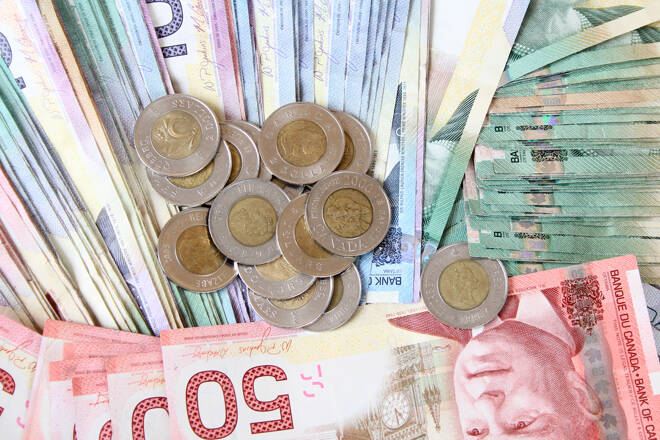Advertisement
Advertisement
USD/CAD: Loonie Strengthens on Higher Crude Oil Prices; Could Turn Volatile
By:
The Canadian dollar extended gains against its U.S. counterpart on Tuesday after hitting an 11-week high in the previous session as rising crude oil prices due to an ongoing global energy crunch continued to support the commodity currency.
The Canadian dollar extended gains against its U.S. counterpart on Tuesday after hitting an 11-week high in the previous session as rising crude oil prices due to an ongoing global energy crunch continued to support the commodity currency.
“USDCAD declines and closes the week well below 1.2500 following the better-than-expected Canadian September jobs report that now needs only a further 200k jobs to be absorbed before BoC starts to consider rate hikes,” noted analysts at Citi.
“For Q4, the solid monthly jobs outcomes together with Citi’s bullish call on Brent crude for the next 6 months, potentially makes CAD the “buy of the quarter in Q4” vs FX funders (USD, JPY, CHF and EUR). The team points to USDCAD headed lower, ultimately targeting a move to the 1.21 handle.”
Canada is the world’s fourth-largest exporter of oil, which edged higher as the global energy crunch continues. At the time of writing, U.S. West Texas Intermediate (WTI) crude futures were trading 0.48% higher at $80.9 a barrel- close to its highest since late 2014.
As the economy recovers, gas and coal prices have also increased, driving oil demand higher and raising crude markets. Higher oil prices lead to higher U.S. dollar earnings for Canadian exporters, resulting in an increased value of the loonie.
Today, the USD/CAD fell to 1.2446, down from Monday’s close of 1.2482. The Canadian dollar gained about 2% so far this month after depreciating around 0.5% in September.
“CAD strengthens with strong crude oil and widening rate differentials. The CAD again led the majors for the week against the USD with a 1.5% gain as it continues to gather support from solid energy prices and generally improving rate differentials against all of the key currencies,” noted Shaun Osborne, Chief FX Strategist Scotiabank.
“With OPEC+ choosing to stick to its November supply increase plans, crude oil prices extended their rise for a fifth consecutive week with WTI crude inching just above $80/bbl mark—a level the benchmark had not touched since November 2014—as the energy markets imbalance continues and high natural gas prices prompt gas-to-oil switching in energy generation. Global equities also recovered some ground this week as the US Senate voted to extend the country’s debt limit to early-December and markets seemed relatively unfazed by financial troubles in China’s real estate sector.”
The dollar index, which measures the value of the dollar against six foreign currencies, was trading 0.18% higher at 94.487. The greenback has gained across most major currencies in the last few weeks as investors have become concerned the Fed may withdraw its economic support due to slow global growth and high inflation.
Investors were concerned that increasing inflationary pressures could pose a headwind to the economy and affect how soon the Federal Reserve may be able to raise rates. Rising bond yields have contributed to the strengthening of the currency.
“Another below consensus US jobs report in Sep with rising inflationary pressures sees higher US. Instead, FX markets remain focused on the recent energy spike and news the US Senate votes to raise the US debt limit until Dec,” added Citi analysts.
“This should make investors more comfortable with holding T-bills near-term and allow USD liquidity flow back into the banking system (and reverse recent USD gains). The path of least resistance, for now, is for the pivotal resistance range at 94.65-79 (which is where the 200w MA converges with the 55m MA, Mar 2020 low and Sep 2020 high), to give way for a potential move to the June 2020 low at 95.72.”
It is highly likely that the world’s dominant reserve currency, the USD, will rise by end of the year, largely due to the expectation of at least one rate hike next year. With the dollar strengthening and a possibility that the Federal Reserve will raise interest rates earlier than expected, the USD/CAD pair may experience a rise.
About the Author
Vivek Kumarauthor
Vivek has over five years of experience in working for the financial market as a strategist and economist.
Advertisement
